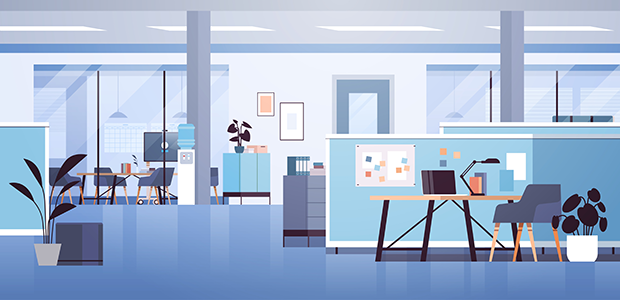
Office space design: the answer to your business’s productivity problem
Unconventional office spaces are generally the exception, not the norm. That’s why the likes of Google’s office, with its indoor slides, ladders, and micro-kitchens, garner so much attention.
The inclusion of theme park-style elements in the workspace bring to mind images of an equally wacky ‘out-of-the-box’ brand identity and young, fun-loving employees. However, businesses across all industries and with diverse workforces can see vast benefits from well-designed office spaces.
It may not yet have been formally declared that Europe is in a recession but following the economic turbulence of the past few years, workforce productivity has become an existential priority for many companies. Future-facing workspaces can have a radical impact on this, particularly when it comes to Total Factor Productivity (TFP). Dubbed the ‘Achilles’ Heel’ of the European productivity challenge, TFP takes into account the capital and technology which are used to boost efficiency and generate outputs in addition to simply measuring employees’ labour. With our research finding that 39% of people’s days are occupied with overcoming technology issues, it’s no wonder that Europe’s TFP signals a stark problem.
By improving office spaces, businesses can radically improve TFP, as well as the creativity and wellbeing of their employees. Here’s how:
The office as a ‘destination’
The role of the office has generated much debate in the hybrid work era with many companies encountering challenges with mandated in office days. Zoom, for example, which was pivotal in aiding remote collaboration during the pandemic, has faced backlash for enforcing its employees’ return to the office.
However, if employees spend more time in the workplace behind screens than interacting with one another, it is unsurprising that they do not see the value in returning to in-person work.
Instead of pitting working in the office against home working, business leaders must recognise that the office is ‘the’ destination for collaboration and creativity. Recently, we found that 64% of European workers would find their jobs more enjoyable if they had more time for creative tasks, with the office space an ideal haven/location for delivering/enabling this.
There are simple steps that companies can take to boost creativity, alongside more radical ones. Simply altering the layout of desks to create a more open, discussion-friendly environment and adding interactive whiteboards to meeting rooms can go a long way in helping employees to problem solve together. Increasing employee engagement in this way will also drive productivity and accelerate business growth.
The impact of next-generation technology
With innovative technology, companies can maximise the employee experience and level-up the benefits that the ‘destination’ office brings. For instance, environmental factors, such as temperature and the percentages of the different gases that make up the air we breathe, can have a huge impact on concentration levels. In fact, the higher the levels of carbon dioxide in a particular space, the more difficult it is to focus. When combined with the all-too-familiar feeling of shivering in a draughty office, or not being able to concentrate due to a sweltering one, it is easy to see the productivity impact of an unsuitable office environment. However, technology exists to alleviate this – by installing environmental sensors, businesses can monitor factors including temperature and air composition and optimise these for their workforce.
Other examples include custom-printed wearables and interactive meeting room technology, which can transcribe notes, detect the level of engagement between meeting participants, and enhance team building by providing personalised recommendations for particular members of the team. These technologies exist to transform collaborative moments and foster innovative thinking.
At Ricoh, we’re continually investing in our digital workspace portfolio to enable our partners to stay ahead of the curve when it comes to seamless collaboration. In fact, we were recently recognised as the third-largest Audio-Visual integrator by Systems Contactor News.
Introducing the Chief Workspace Officer
All too often, the management of the physical workplace comes as an after-thought and is assigned to an individual who already has too many responsibilities on their plate. In some ways, this reflects the position of office design in business leaders’ priorities. But if companies wish to reap the benefits of embedding cutting-edge technology in the physical workspace can have, they need to employ dedicated teams who are available and qualified to monitor the equipment. Equally, they must be on hand to adapt the space if a particular layout is not working as intended and such teams need to have a deep-understanding of human-centric design. ‘Office management’ positions must be given the recognition and seniority they deserve.
Finally, the prospect of hiring additional headcount, alongside equipment costs, is undoubtedly daunting. However, the benefits of a well-designed office space, which can ultimately foster great employee workplace experience, are too significant to be missed and leaders should be encouraged to downsize their vast, empty offices in favour of smaller, more expertly-planned spaces that enable increased employee interaction. After all, it’s only when leaders acknowledge and understand the value of a well-designed workspace and see it as central to business performance, that employees will unleash their full potential.

